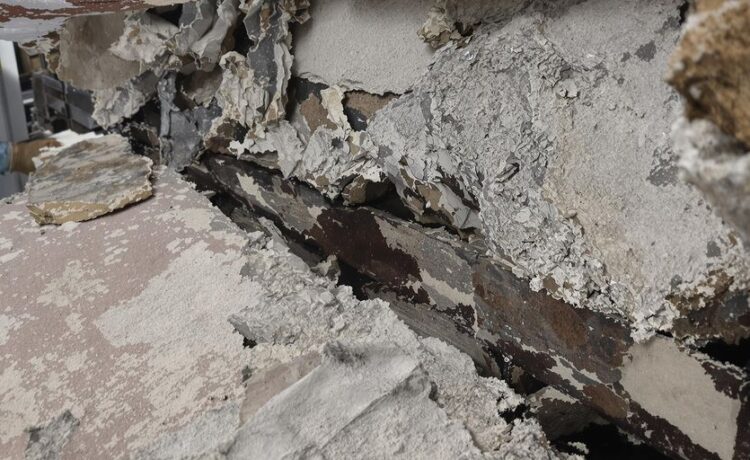What Is Asbestos and Why Was It Used?
Asbestos is a naturally occurring mineral that was once a staple in construction due to its durability, fire resistance, and insulating properties. For decades, it was considered a “miracle material” and was widely incorporated into homes built before the late 20th century. However, its microscopic fibers, when disturbed, can become airborne and pose serious health risks. Understanding its historical purpose is key to recognizing its potential dangers in older homes.
Common Household Materials Containing Asbestos
Many household materials manufactured before the 1980s may still contain asbestos. These include:
- Insulation around pipes and boilers.
- Ceiling tiles and textured paints.
- Vinyl flooring and adhesives.
- Roofing materials, including shingles and felt.
- Cement sheets and siding.
If your home was built before the 1980s, it’s worth investigating whether these materials might be present. Identifying asbestos before starting renovations can prevent accidental exposure.
Health Risks Associated With Asbestos Exposure
Exposure to asbestos fibers can lead to severe health complications. The most well-known illnesses include asbestosis, lung cancer, and mesothelioma—a rare but aggressive form of cancer. These conditions often develop years after exposure, making early detection difficult. Even brief exposure can pose risks, especially when asbestos-containing materials are disturbed during renovations. For more on the dangers of asbestos, it’s important to understand its impact on respiratory health and beyond.
Historical Use of Asbestos in Residential Construction
Asbestos in Mid-20th Century Homes
During the mid-20th century, asbestos was a common material in residential construction. Homes built between the 1950s and 1970s often featured asbestos in a variety of applications, from insulation to floor tiles. Its widespread use was largely due to its affordability and fire-resistant properties. Homeowners today should be aware that older properties may still contain asbestos, posing potential health risks if disturbed. Homes built between the 1950s and 1970s are particularly at risk, making it essential to identify and address asbestos before starting any renovations.
Why Asbestos Was Popular in Building Materials
Asbestos gained popularity in construction because of its unique properties. It was not only resistant to heat and fire but also durable and easy to incorporate into building materials. Manufacturers used it in everything from roofing shingles to pipe insulation. The material’s versatility made it an attractive option for builders, despite the health risks that were not fully understood at the time. Its affordability also contributed to its widespread adoption, especially in post-World War II housing booms.
Regulations That Phased Out Asbestos Use
By the late 1970s, the dangers of asbestos exposure became undeniable. The Environmental Protection Agency (EPA) and other regulatory bodies began implementing strict rules to limit its use. Asbestos was banned in new homes in states like South Carolina and Georgia during this time. These regulations marked a turning point, gradually phasing out asbestos in construction materials. However, older homes still pose challenges, as many were built before these bans took effect.
Modern Renovation Trends and Their Impact on Asbestos Exposure
The Rise of DIY Home Renovations
DIY home projects have become incredibly popular in recent years. Many homeowners are eager to save money and add a personal touch to their spaces. However, this hands-on approach can unintentionally disturb hidden asbestos in older homes. Without proper knowledge, DIY enthusiasts may unknowingly expose themselves and their families to asbestos fibers. Common tasks like removing old tiles, sanding walls, or tearing out insulation can release these dangerous particles into the air, creating serious health risks.
Increased Popularity of Vintage Home Restorations
Restoring vintage homes has also gained traction, with many people wanting to preserve the charm of older architecture. While this trend brings a sense of nostalgia, it often comes with the challenge of dealing with outdated, hazardous materials. Asbestos, frequently used in mid-20th century construction, can be lurking in everything from plaster walls to ceiling tiles. Renovators need to be cautious, as disturbing these materials can lead to contamination throughout the house. Hiring professionals for testing and abatement is often the safest route.
How Open-Concept Designs May Disturb Asbestos
Open-concept designs are another popular trend, requiring the removal of walls and other structural changes. These renovations can expose asbestos hidden in joint compounds, wallboards, or even floor adhesives. When walls are demolished, the risk of releasing asbestos fibers skyrockets. Homeowners should prioritize safety by consulting experts before starting any major structural changes. Following laws and safety measures ensures both compliance and protection from long-term health dangers.
Identifying Asbestos Before Starting Renovations
Signs Your Home May Contain Asbestos
If your home was built before the 1980s, there’s a chance it contains asbestos. It was commonly used in materials like insulation, flooring, and roofing due to its durability and heat resistance. Homes with popcorn ceilings, vinyl tiles, or old ductwork are particularly suspect. You might also notice crumbling or damaged materials, which could be releasing asbestos fibers into the air. When in doubt, it’s always better to assume asbestos is present and proceed cautiously.
Hiring Professionals for Asbestos Testing
Testing for asbestos isn’t something you should handle on your own. Certified professionals have the tools and expertise to safely collect samples without causing unnecessary exposure. They’ll analyze materials in a lab to confirm whether asbestos is present. Hiring experts can save you from the health, legal, and financial risks linked to improper handling. Look for licensed asbestos inspectors who follow strict safety protocols to ensure accurate results.
Legal Requirements for Asbestos Identification
Before starting renovations, it’s important to understand the legal obligations tied to asbestos. Many regions require testing and documentation, especially for older homes. The asbestos NESHAP regulations outline specific practices for handling asbestos during demolition or renovation. Failing to comply can result in hefty fines or delays in your project. Always check local laws and hire qualified professionals to stay on the right side of the law.
Safe Practices for Handling Asbestos During Renovations
Protective Gear and Equipment for Asbestos Removal
When dealing with asbestos, proper protective gear is non-negotiable. This includes wearing a high-quality respirator designed to filter asbestos fibers, disposable coveralls to prevent contamination, and gloves to protect your skin. Safety goggles are also essential to shield your eyes from airborne particles. Ensure all gear is rated for asbestos work and fits securely to minimize exposure risks.
Steps to Minimize Asbestos Disturbance
Handling asbestos-containing materials requires a cautious approach. Follow these steps to reduce the risk of disturbance:
- Wet the Area: Spraying water on asbestos materials helps to suppress dust and prevent fibers from becoming airborne.
- Avoid Breaking Materials: Intact materials release fewer fibers, so avoid cutting, sanding, or breaking them.
- Seal Off the Work Area: Use plastic sheeting and duct tape to isolate the space, preventing fibers from spreading to other parts of the home.
These measures significantly lower the chances of exposure and keep the environment safer for everyone.
When to Call in Certified Asbestos Abatement Experts
While some small tasks can be managed with care, larger or more complex projects should always involve professionals. Certified asbestos abatement experts have the training, equipment, and experience to handle asbestos safely. They follow strict protocols to remove and dispose of materials correctly, ensuring compliance with regulations. Homeowners should consult guidance on the safe handling and disposal of asbestos to understand when professional intervention is necessary.
Health Implications of Asbestos Exposure During Renovations
Short-Term vs. Long-Term Health Effects
When asbestos-containing materials are disturbed during renovations, tiny fibers can become airborne and inhaled. While short-term exposure is less likely to cause immediate symptoms, it’s not without risks. Prolonged or repeated exposure, however, can lead to severe health problems over time. The long-term effects of asbestos exposure can be life-altering, often surfacing decades after the initial contact. These include chronic respiratory issues and life-threatening diseases.
Understanding Mesothelioma and Other Diseases
One of the most severe illnesses linked to asbestos exposure is mesothelioma, a rare cancer that affects the lining of the lungs, abdomen, or heart. Other diseases include asbestosis, a chronic lung condition, and lung cancer. Even minimal exposure can increase the risk of developing these conditions, making it critical to handle asbestos with extreme care during renovations.
How Asbestos Exposure Affects Families
Asbestos exposure doesn’t just impact the individual directly exposed. Family members can also be at risk through secondary exposure, such as asbestos fibers clinging to clothing or tools. This unintentional transfer can lead to serious health problems for loved ones, emphasizing the importance of proper safety measures during any renovation project. For more on how asbestos poses a significant health risk during home repairs, read here.
Legal and Financial Considerations in Asbestos Management
Costs Associated With Asbestos Removal
Managing asbestos during renovations can be expensive, but it is a necessary investment for safety. The cost of removal depends on factors like the size of the area, the condition of the asbestos, and the complexity of the job. Homeowners should budget for professional abatement services, which can range from a few hundred to several thousand dollars. Cutting corners to save money can lead to serious health risks and legal consequences. Some states even offer financial assistance or tax incentives to offset these costs.
Insurance Coverage for Asbestos-Related Issues
Many homeowners are surprised to learn that standard insurance policies often do not cover asbestos removal or related damages. It’s important to review your policy carefully and speak with your provider about additional coverage options. Some insurance plans may cover damages caused by accidental asbestos exposure but exclude pre-existing conditions. For peace of mind, consider specialized asbestos coverage if you live in an older home.
Legal Penalties for Improper Asbestos Handling
Improper handling of asbestos isn’t just dangerous—it’s illegal. Violating asbestos regulations can result in hefty fines, lawsuits, or even criminal charges. For instance, failing to follow disposal laws or attempting DIY removal without proper permits can lead to significant penalties. In some cases, victims of exposure have filed asbestos lawsuits under legal theories like negligence or strict liability. To avoid legal trouble, always hire certified professionals and follow local regulations to the letter.
Environmental Impact of Asbestos Disposal
Safe Disposal Methods for Asbestos Waste
Handling asbestos waste is a delicate process, as improper methods can release harmful fibers into the air and soil. Ensuring asbestos is disposed of safely protects public health and the environment. The following steps outline safe disposal practices:
- Double-bag asbestos materials in heavy-duty plastic bags, sealing them securely.
- Clearly label the bags with warnings to prevent accidental mishandling.
- Transport the waste to a designated landfill that is approved for asbestos disposal.
These steps reduce the risk of exposure and contamination, making them essential for proper asbestos management.
Environmental Regulations on Asbestos
Governments worldwide have implemented strict regulations to manage asbestos disposal. These laws dictate how asbestos should be handled, transported, and disposed of to minimize its environmental impact. For instance, environmental asbestos exposure can result from improper disposal methods, as outlined in Environmental asbestos exposure arises from disturbing natural deposits, processing asbestos ore, and improper disposal practices. Compliance with these regulations helps protect not just human health but also ecosystems from long-term damage.
The Role of Landfills in Asbestos Management
Landfills play a critical role in containing asbestos waste. These sites are specially designed to prevent asbestos fibers from escaping into the environment. Features like lined pits and controlled access ensure that asbestos remains safely contained. However, landfill capacity is a growing concern, as the demand for asbestos disposal sites increases. Effective management of these facilities is vital to address this challenge and maintain environmental safety.
Raising Awareness About Asbestos in Home Renovations
Educational Campaigns on Asbestos Risks
Raising awareness starts with education. Many homeowners remain unaware of the dangers lurking in older building materials. Educational campaigns that focus on the hidden risks of asbestos can make a significant difference. These campaigns can include workshops, online resources, and even community events aimed at informing people about what asbestos is, where it might be found, and why it’s dangerous. For example, local governments and health organizations can collaborate to spread this knowledge effectively.
Community Programs for Safe Renovation Practices
Community-based initiatives play a big role in promoting safer renovation habits. Programs could focus on teaching homeowners how to identify potential asbestos-containing materials and what steps to take if they suspect exposure. These efforts might include free or low-cost asbestos testing kits, training sessions on safe handling, or even partnerships with certified abatement professionals. Such programs not only protect individual families but also create a culture of safety within the community.
The Role of Media in Highlighting Asbestos Issues
The media has the power to bring asbestos risks into the spotlight. Through news stories, documentaries, and even social media campaigns, the dangers of asbestos exposure during renovations can reach a broader audience. Highlighting real-life cases where asbestos was improperly handled can serve as a cautionary tale, encouraging better practices. Additionally, media outlets can provide practical advice, such as what to do if asbestos is found—like halting work immediately, sealing off the area, and contacting authorities for safe removal.
Future Trends in Renovation and Asbestos Management
Innovative Technologies for Asbestos Detection
As technology advances, new tools are emerging to make asbestos detection faster and more accurate. For instance, portable devices equipped with advanced sensors are being developed to identify asbestos fibers on-site without the need for extensive lab analysis. These tools can save time and reduce costs for homeowners and contractors alike. One of the most promising developments is the use of AI-powered analysis, which can process data from samples more efficiently than traditional methods. Such innovations aim to make asbestos surveys essential and accessible to a broader audience.
Sustainable Alternatives to Asbestos Materials
The construction industry is shifting towards greener, safer materials to replace asbestos. Alternatives like cellulose fiber, polyvinyl alcohol (PVA) fiber, and even recycled materials are gaining traction. These options not only reduce health risks but also minimize environmental impact. Builders are increasingly adopting these materials to meet stricter safety and sustainability standards. This trend reflects a growing awareness of the need for eco-friendly solutions in modern construction.
How Policy Changes May Shape Renovation Practices
Government policies play a significant role in how asbestos is managed during renovations. Stricter regulations on asbestos handling and disposal are being introduced in many regions, pushing for better compliance and safer practices. On the other hand, incentives for using non-asbestos materials or hiring certified professionals for asbestos removal are encouraging homeowners to opt for safer renovation methods. As these policies evolve, they are likely to drive innovation and improve safety standards across the industry.
Additional Help
Robert King Mesothelioma Law Services













